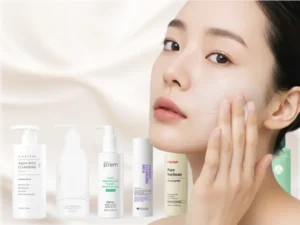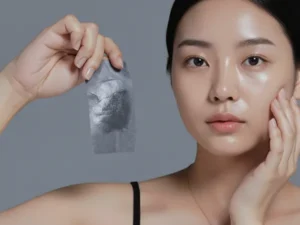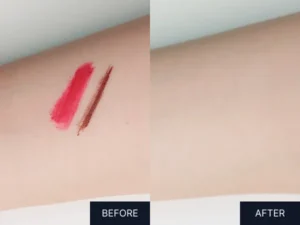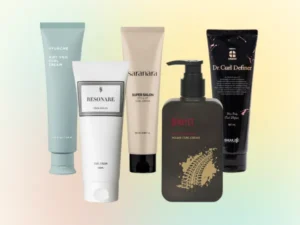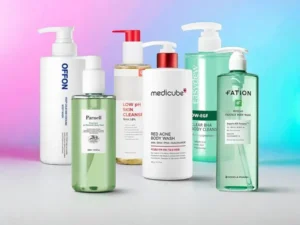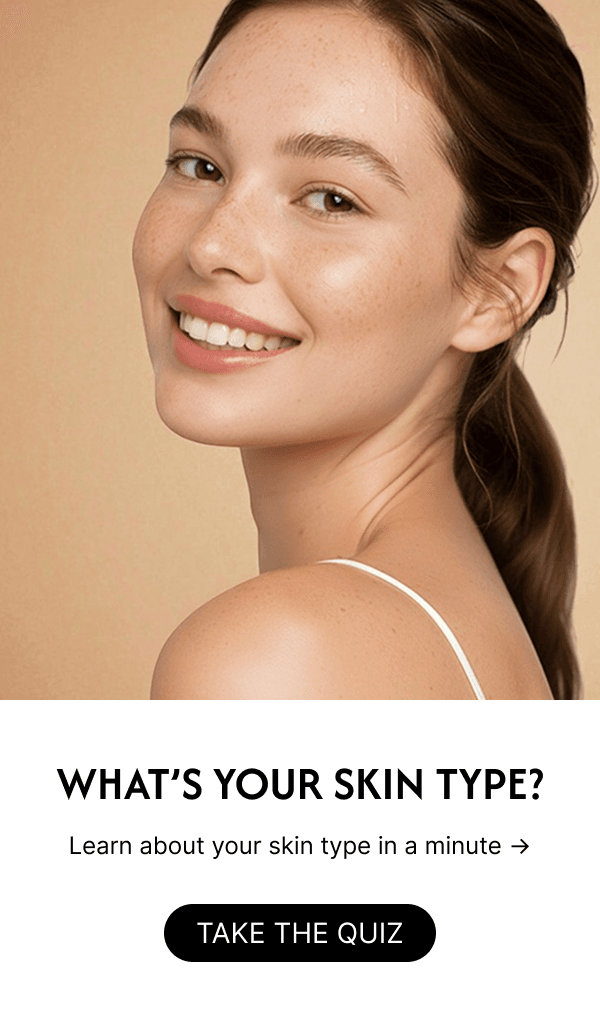One of the most common questions dermatologists hear is about cleansing techniques. Just as they say, cleansing is the first step in skincare; learning how to double cleanse correctly is essential for healthy skin.
If you’ve been wondering about this cleansing method, you’ve come to the right place. This comprehensive guide answers every question you might have about double cleansing and is likely the most thorough resource you’ll find on mastering this method.
What You’ll Learn:
- What double cleansing is
- The science behind why double cleansing works
- When you actually need to double cleanse (and when you don’t)
- How to double cleanse without irritating your skin
- Common mistakes that can sabotage your results
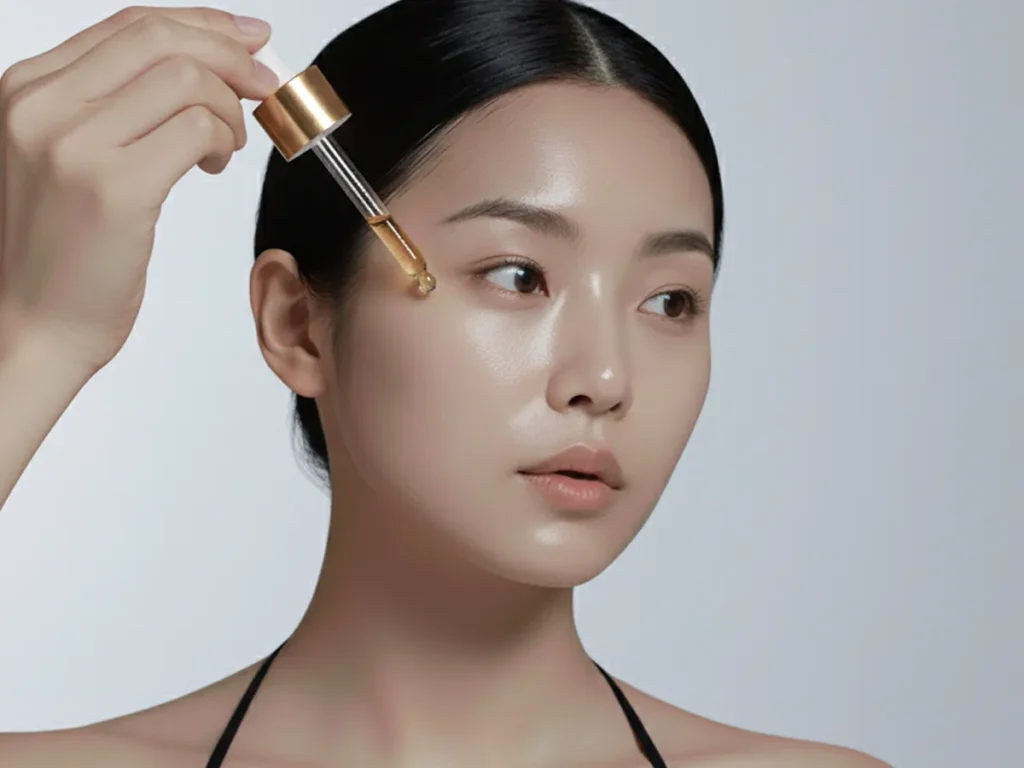
What Is a Double Cleanse?
Double cleansing is a two-step facial cleansing method designed to target different types of impurities. The first step uses an oil-based cleanser to break down oil-based residues such as makeup, sunscreen, and excess sebum.
The second step uses a water-based cleanser to remove the dissolved oil and water-soluble impurities like sweat, dirt, and dust.
When done correctly, double cleansing helps clear pores thoroughly and leaves skin feeling clean without stripping it. However, choosing products that suit your skin type is crucial, and using the wrong cleanser can lead to irritation or dryness.
The Science of Why Double Cleansing Works
Research published in the Journal of Cosmetic Dermatology found something important: oil cleansers work much better than regular face wash at removing sunscreen, both the everyday kind and waterproof formulas [1]. This matters because leftover sunscreen can clog your pores and prevent your skincare from working properly.
The Korea Consumer Agency tested something similar and found that half of the most popular face washes couldn’t completely remove sunscreen. The gentle, pH-balanced cleansers that dermatologists usually recommend? They’re actually too mild for this job. Interestingly, while these face washes struggled with sunscreen, they had no trouble washing away cleansing oils [2].
This is exactly why skincare experts recommend starting with an oil cleanser in a double cleanse. Impurities like sebum, sunscreen, waterproof makeup, and many environmental pollutants are oil-based and are most effectively broken down by an oil-based cleanser [3].
After the oil cleanser does its heavy lifting, that’s when your regular face wash comes in. It removes everything else: sweat, dirt, pollution, and any leftover oil cleanser. This step ensures your skin is fully clean without being stripped or dried out. Plus, clean skin absorbs your serums and moisturizers much better.
The key is making sure you wash away all the oil cleanser in step two. Any leftover residue can block your pores and cause breakouts, which defeats the whole purpose of double cleansing.
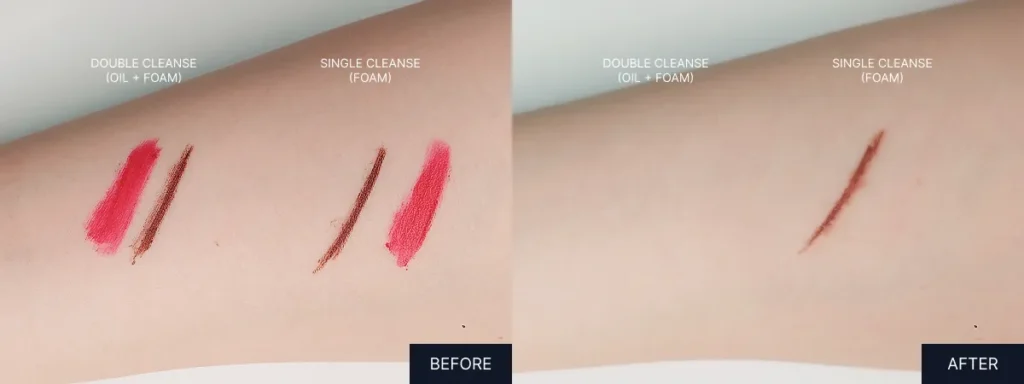
Benefits of Double Cleansing
Here’s a quick look at the benefits of double cleansing:
- Effectively removes makeup and sunscreen
- Reduces blackheads and clogged pores
- Brightens complexion
- Improves absorption of skincare products
When & How Often Should You Double Cleanse?
While double cleansing is a popular skincare tactic, it can backfire if you make it a daily habit. A university study found that over three weeks, women who double cleansed daily had a noticeable drop in skin hydration and oil balance compared to those who used cleansing oil alone [4].
When is double cleansing needed?
Double cleansing can be useful, but it’s best done selectively. Here are the situations where it makes sense.
1. When Wearing Makeup
If you wear makeup, double cleansing is a must. Products like foundation, cushion, concealer, and most color cosmetics are oil-based, which means a foam cleanser alone can’t fully break them down.
Start with an oil cleanser to melt away the makeup, then follow up with a water-based cleanser to wash off the residue. Skipping this step can leave product sitting in your pores, leading to breakouts and irritation.
For waterproof mascara, eyeliner, or long-lasting lip tints, it’s best to use a dedicated lip and eye remover before going in with your oil cleanser.
2. When Wearing Thick or High-Coverage Sunscreen
Dermatologists have different opinions on whether double cleansing is necessary after sunscreen. The bottom line: to fully remove sunscreen, double cleansing is recommended. But doing it every day with frequently applied sunscreen can weaken the skin barrier.
Dr. Hyun-Chul Shim, head dermatologist at The Cell Skin Clinic, recommends double cleansing for functional sunscreens like tone-up creams, BB creams, CC creams, or dense, high-coverage formulas. For those mostly staying indoors, he advises using lighter, lower-density sunscreen and sticking to a single cleanse[5].
Why should you double cleanse for thicker, dense sunscreen? Dense sunscreens generally contain mineral UV filters like zinc oxide or titanium dioxide, which can easily clog pores. On the other hand, lighter sunscreens, often organic-based or “easy wash-off” formulas, typically don’t require double cleansing.
3. On Days with Excess Sebum
If you have oily or combination skin, there are days when sebum production feels heavier than usual. A single cleanse may not be enough to clear away the buildup of oil and impurities.
Starting with an oil-based cleanser helps dissolve the excess sebum since oil mixes best with oil. Following up with a water-based cleanser ensures your pores are thoroughly cleaned, which can help prevent breakouts.
4. On Days With Fine Dust or Pollution
When fine dust settles on the skin, it can generate free radicals. These unstable molecules damage cells, trigger inflammation, and accelerate skin aging.
After a day of heavy pollution exposure, double cleansing helps remove trapped particles from your pores and keeps your skin healthier. To avoid extra irritation, stick with gentle, low-irritant cleansers since your skin may already be stressed from pollution.
When Should You NOT Double Cleanse
Double cleansing isn’t necessary for everyone, and overdoing it can actually harm your skin. If you skip makeup or heavy sunscreen, a single gentle cleanse is more than enough. Excessive cleansing can strip the skin barrier, leaving your skin dry, tight, or irritated.
Here are the most common situations where a single cleanse is sufficient:
- In the morning: Overnight buildup is typically light. A gentle water-based cleanser alone can remove sweat, oils, and debris.
- On no-makeup, no-sunscreen days: Light dust and environmental impurities can be cleared with just one cleanse.
- If your skin is very dry or sensitive: Over-cleansing can damage the skin barrier further and worsen dryness or irritation.
How to Double Cleanse: Step-by-Step Guide
Step 1: Oil-Based Cleanser
Types: Cleansing oil, cleansing balm, cleansing milk, cleansing lotion
- Wash your hands thoroughly and dry them completely.
- Apply the cleanser to dry hands and a dry face. Gently roll it over your skin for about 30 seconds to dissolve makeup and sunscreen.
- Wet your hands with lukewarm water and continue rolling for another 30 seconds. This emulsification process turns the oil milky, helping lift impurities effectively.
- Rinse thoroughly with lukewarm water.
Step 2: Water-based Cleanser
Types: Foam cleanser, gel cleanser, powder wash, cream cleanser
- Lather the cleanser in your hands first to create foam.
- Massage the foam gently over your face, keeping your fingers relaxed to minimize friction.
- Rinse thoroughly with lukewarm water to remove all residue.
For step two, use a mild, slightly acidic cleanser. These cleansers don’t naturally produce a lot of foam, so create as much lather as possible and use the tiny bubbles to gently massage your skin. This helps minimize friction and irritation. You can also use a foam net to achieve a gentle yet effective cleanse.
Step 3: Skincare After Double Cleansing
Once you’ve finished double cleansing, it’s best to apply your skincare products as soon as possible. Start with lighter formulations and gradually layer thicker skincare for optimal absorption.
Choose products that help replenish moisture and strengthen the skin barrier. Skincare containing ingredients like hyaluronic acid, ceramides, and niacinamide is highly recommended for this purpose.
The most important factors when double cleansing are a gentle touch and the right duration. Rubbing too long or applying excessive pressure while rolling can damage the skin barrier and lead to irritation. If you’re new to proper cleansing techniques, learn more about how to wash your face properly for additional foundational tips that apply to both single and double cleansing routines.
Who Should Avoid Double Cleansing?
Very sensitive or compromised skin barriers
If your skin is very sensitive or has a weakened barrier, it’s best to skip oil-based double cleansing. Instead, use a foam maker or foaming bottle with cleansing water. This helps remove makeup and sunscreen while minimizing friction and contact with the skin. Make sure the cleansing water has adequate cleansing power, and follow up with a gentle, pH-balanced cleanser to complete your routine.
Extremely dry skin types
If your skin is very dry, it’s best to avoid double cleansing and focus on hydrating skincare to restore moisture. If you need to wear makeup or heavy sunscreen, keep the oil cleansing brief (around 30 seconds) and follow quickly with a gentle foaming cleanser (around 30 seconds). Finish with a sheet mask or modeling mask that provides soothing and hydrating benefits to nourish your skin.
Stressed skin
If your skin is stressed from lack of sleep, high pressure, or a packed schedule, it’s best to skip double cleansing. This routine isn’t the gentlest on the skin, and overdoing it can worsen sensitivity or dryness. Even Korean idols, known for their intensive skincare routines, often avoid double cleansing when their skin needs a break.
Dermatitis and Acne-prone Skin
For those with dermatitis or acne, double cleansing with an oil-based cleanser can actually make the skin worse. Many dermatologists advise against using cleansing oils for double cleansing because they can worsen inflammation or be difficult to rinse off completely.
Dr. Hyun-Jung Kim, dermatologist at Sejong Chungnam National University Hospital, recommends that people with acne avoid traditional oil-and-foam double cleansing. Instead, she suggests using a cleansing wipe, followed by a foaming cleanser just to rinse the skin [6].
Those with specific skin conditions
If you have skin conditions beyond sensitive, acne-prone, or redness-prone skin, it’s best to consult a professional dermatologist before adding double cleansing to your routine. This ensures you choose the safest approach for your skin type and avoid potential irritation or flare-ups.
Common Mistakes To Avoid
Mistake #1: Using cleansing oil on wet hands
Always apply your oil-based cleanser to clean, dry hands and a dry face. If the oil meets water too early, it will start to emulsify before reaching your skin, reducing its effectiveness at breaking down makeup, sunscreen, and sebum.
Mistake #2: Not emulsifying your oil cleanser
Cleansing oils need to be emulsified because oil and water naturally don’t mix. Without emulsification, it’s difficult to rinse away oil and impurities completely. Emulsifiers in cleansing oils transform the oil into a milky, water-soluble substance when it comes into contact with water. This process allows the oil to effectively break down makeup, sunscreen, excess sebum, and environmental pollutants while rinsing off cleanly without leaving a greasy residue.
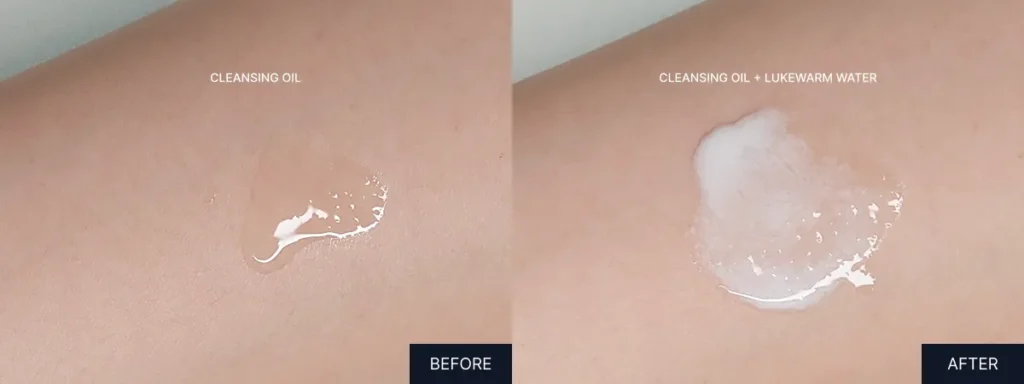
Mistake #3: Over-massaging or aggressive cleansing
You should never wash your face aggressively, whether you’re double cleansing or using a single cleanse. The skin needs gentle care, as harsh scrubbing can damage the skin’s protective barrier, strip natural oils, trigger overproduction of sebum, increase sensitivity and redness, and even accelerate premature aging.
Mistake #4: Using products in the wrong order
In double cleansing, the order matters. Oil-based cleansers should always come first to break down makeup, sunscreen, and other oily impurities. Using an oil cleanser last defeats the purpose of double cleansing and can leave residues behind.
Mistake #5: Wrong product selection
Avoid using overly heavy oil cleansers, including Vaseline. Look for oil cleansers that effectively break down makeup and sunscreen, emulsify easily, and rinse off completely. For the water-based step, choose a gentle, low-pH cleanser to finish your double cleanse without irritating your skin.
Mistake #6: Not following up with proper skincare
Hydration is essential after double cleansing or any deep cleanse. Use water-soluble moisturizers, such as low-molecular hyaluronic acid serums or ampoules, to replenish moisture. Any additional skincare treatments should be chosen based on your skin type and concerns.
Takeaway
Double cleansing is a two-step method: start with an oil-based cleanser to remove makeup, sunscreen, and excess oil, then follow with a water-based cleanser to wash away remaining impurities.
This method isn’t necessary every day. Use it only when wearing makeup, thick sunscreen, or on high-pollution days. Apply the oil cleanser to dry hands and face, massage for about 30 seconds, add water to emulsify, then rinse. Finish with a gentle water-based cleanser.
Verdict: Double cleansing is not a one-size-fits-all rule for skincare. It’s simply a tool that can be used flexibly depending on your skin’s condition and daily activities.
FAQs
Sources
- Matsubara, A., Ueki, R., & Ishii, M. (2020). The optimal cleansing method for the removal of sunscreen: Water, cleanser, or cleansing oil? Journal of Cosmetic Dermatology, 19(1), 180–184. https://doi.org/10.1111/jocd.12995
- Korea Consumer Agency. (2024, November 19). 폼클렌저, 자외선차단제 제거 성능 제품에 따라 차이 있어요 [Foaming cleansers: Sunscreen removal performance varies by product]. https://www.kca.go.kr/home/sub.do?menukey=4004&mode=view&no=1003752683
- Mukhopadhyay, P. (2011). Cleansers and their role in various dermatological disorders. Indian Journal of Dermatology, 56(1), 2–6. Doidoi.org/10.4103/0019-5154.77542
- Song, J., Kim, B., & Choi, E. (2010). The actual status of face washing in women in their 20s and 30s and the influence of cleansing oil upon the improvement of their facial skin dryness. Journal of the Korean Society of Aesthetics and Cosmetology, 8(4), 11–20.
- The Cell Skin. (2023, January 24). 올바른 클렌징 순서! – 선크림만 발라도 이중세안 해야하나요? [피부과전문의 피부심]. YouTube. https://www.youtube.com/watch?v=ZesTkwCDpPo
- Kim, H. J. (2024, April 16). Interview on CBS 오뜨밀 [CBS Ottmeal]. FM 98.1. NaverCBS 오뜨밀

